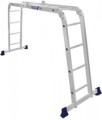Number of steps
The total number of steps provided in the design of the stairs. This parameter is indicated rather for reference — the primary characteristic is still the height of the stairs. Note that when calculating the number of steps, the footboard is also taken into account (see below).
Material
The material from which the staircase is made (or at least the main part of its structure).
—
Aluminium. Aluminium-based alloys combine quite decent strength and corrosion resistance with low weight. The latter is especially important for stairs that are long — almost all of them are made of this material. And in general, it is quite widespread.
—
Steel. Steel is notable primarily for its high strength, in which it significantly exceeds aluminium; while it costs a little less. On the other hand, the weight of this material is also significantly greater. Therefore, it is mainly used in small ladders, in particular, mini-ladders (see "Type").
—
Tree. Wood is familiar to many from the simplest "rural" stairs, but it is very rare in modern models — at a rather high cost, this material is less practical than aluminium or steel.
—
Fiberglass. The term "fiberglass" itself literally means fiberglass, but in this case we are talking about fiberglass — a composite material that combines fiberglass threads with a binder polymer (plastic). Such a material is characterized by high strength with low weight, does not corrode, and does not conduct electricity, which makes it perfect for dielectric models (see below). Its main disadvantage can be called a rather high cost.
Max. height
The maximum working height of the ladder. In models that do not have a footboard (see above), this parameter is usually indicated in the specifications for the total length of the stairs. It is worth noting here that the height of the upper step in such cases rarely corresponds to the working height to the nearest centimeter - firstly, the stairs are almost never strictly vertical, and secondly, the outermost steps are usually not on the very edge. However, in most cases this difference can be neglected. If the design provides for a footboard, then the height is measured along it.
When choosing a ladder by height, it should be taken into account that the longer the structure, the greater its weight and, usually, the higher the price. Therefore, buying a model with a long length makes sense only when there is a real need for it.
Dimensions (folded) (LxW)
Ladder dimensions in fully folded position. The smaller they are, the more convenient the ladder will be in storage and transportation. Usually, only the length and width are indicated in the characteristics, because. the thickness of modern stairs is very small and in most cases it can be neglected; and in some models, only the length may be indicated at all — for the same reasons.
Weight
The total weight of the ladder. On the one hand, the lighter the model you choose, the more convenient it will be to carry, the less effort will be expended. On the other hand, lighter weight means less material used in the construction of the stairs, and this can adversely affect reliability. Therefore, it is worth choosing an option for this parameter depending on the planned features of the application. If the expected load on the ladder is significantly lower than the maximum, then you can not pay close attention to the weight. But if you have doubts and/or plan to work in difficult conditions with a heavy load, you should choose the more massive one from two models with the same characteristics. It is unlikely that this will seriously affect the cost of forces, but the risk of breakage and a dangerous fall will decrease significantly.

